Class 9 MAHARASHTRA STATE TEXTBOOK BUREAU Solutions Science Chapter 2 - Work and Energy
Work and Energy Exercise Exercise
Solution 1a
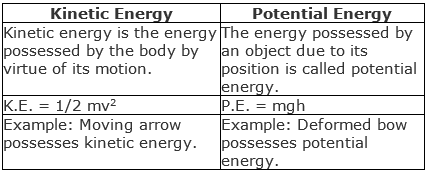
Solution 1b
Consider a body of mass m initially at rest.
If on application of force F, it travels a distance s, then
Work done, W = F x s
By Newton's second law, F = ma
W = ma x s
where, a = acceleration
Using equation of motion v2 - u2 =2as, we get
(v2-u2)/2 = as
W = m x (v2 - u2)/2
As initial velocity is zero, W = ½mv2
This work done is stored as kinetic energy of the object.
So, KE = ½ mv2.
Solution 1c
Consider a body of mass m placed at A.
h = AB is the height of the body above the ground
u = 0 is initial velocity at A
v1 = velocity of body at C
v = velocity of body at B, i.e., just above the ground
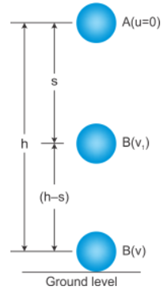
(i) At point A
PEA = mgh
KEA = 0
Total mechanical energy at A, EA = PEA + KEA = mgh + 0 = mgh
(ii) At point C
v12-0 = 2gs
v12 = 2gs
KEC = ![]()
PEC = mg(h-s)
Total mechanical energy at C, EC = PEC + KEC = mg(h-s) + mgs = mgh
(iii) At point B
v2-02 = 2gh
v2 = 2gh
KEB = ![]()
PEB = 0
Total mechanical energy at B, EB = PEB + KEB = 0 + mgh = mgh
The total mechanical energy of the body at A, B and C (also at any other point in the path AB) is the same. So, the total mechanical energy of the body throughout the free fall is conserved.
Solution 1d
Given that,
Angle, θ = 30°
Now,
Work done = Force × displacement
∴ W = Fd cosθ = Fd × cos 30°
i.e.,
Thus for the give case, the potential energy will be minimum when we are sleeping on ground.
Solution 1e
Momentum p is the product of mass m and velocity v
p = m v ..................(1)
Kinetic energy K is defined as,
K = (1/2)×mv2........... (2)
From eqn. (1) and eqn. (2), we can write,
K = p2/(2m) ...............(3)
We see from eqn. (3),
If momentum p = 0, then kinetic energy K also zero.
Solution 1f
As we know, the Centripetal force is perpendicular to the movement direction of object.
Hence there will be no work done for moving the object in uniform circular motion.
Solution 2a
Answer: i
According to the work energy theorem, energy must be transferred from one form to another in order for work to be performed.
Solution 2b
Answer: ii and iv
As we know S.I unit of both work and energy is Joule, whereas unit of power is J/sec and for force is Newton.
Solution 2c
Gravitational force and vertical reaction force have the same magnitude when dragging a heavy object across a smooth horizontal surface.

Furthermore, because friction is always zero, it can be treated as constant.
Solution 2d
Answer: i
Power is defined as the rate of doing work or the rate of transfer of energy.
Power = Work done / time taken
Its SI unit is watt (W).
Thus, power is measure of the rapidity with which work is done.
Solution 2e
Answer: Gravitational force
Negative work - When the force is acting opposite to the direction of the displacement, the work done by the force is taken as negative.
Example: When we lift an object two forces act on the object.
In our case, work done be negative by gravitational force since, the direction of force will be opposite to the direction of the displacement.
Solution 3a
Answer: iv
Now, potential energy is given as
Section name
Solution 3b
Answer: ii
Let us assume an object of mass m is dropped from a height h above ground level.
Initially just before dropping this object does not have any kinetic energy, it has only potential energy.
Hence total energy = kinetic energy + potential energy
= m×g×h ...............................(1)
where g is acceleration due to gravity.
Let us calculate the total energy at a height y above ground level, in between the initial height h and ground level.
potential energy = m×g×y ...........................(2)
kinetic energy = (1/2) ×m×v2.......................(3)
where v is the speed attained by the object at the height y.
Since the distance travelled by the object is (h-y) we get from equation of motion, v2 = 2×g×(h-y)
by substituting for v2 in eqn. (3) we get
kinetic energy = (1/2) ×m×2×g×(h-y)
= m×g×(h-y) ..................(4)
By adding eqn.(3) and eqn.(4), we get
total energy = m×g×y + m×g×(h-y)
= m×g×h ...........(5)
When the object reaches ground level, its potential energy is zero .
At ground level, just before hitting the ground,
kinetic energy = (1/2)×m×v2 = (1/2)×m×(2×g×h)
= m×g×h ......................(6)
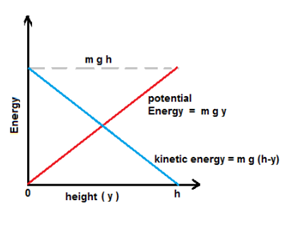
From eqn. (1), (5) and (6), we can conclude that total energy m×g×h always remains same, hence total energy is conserved.
Solution 3c
Answer: ii
As we know,
Potential energy = mass × acceleration due to gravity× height.
Hence, we can conclude that if we increase the velocity of a car moving on a flat surface to 4 times of its original volume then its potential energy will not change.
Solution 3d
Answer: iii
Now,
Work done = Force × displacement
∴ W = Fd cosθ
Hence, we can conclude that the work done on an object does not depend on initial velocity of the object.
Solution 4.1
Now, for the given case at the moment of releasing the ball, it will only have potential energy and its magnitude is given by.
Section name
Solution 4.2
For the given case, as the ball roll down the channel the potential energy will be converted into kinetic energy as we can see below.
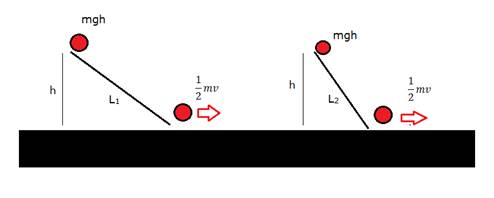
Solution 4.3
In the given case, we know that the balls will have the same potential energy because the channels are the same height and weight. As a result, when the balls reach the bottom of their respective channels, they will have the same kinetic energy. As a result, the balls will have the same velocity at the channel's bottom. Because they have the same velocity, they will travel the same distance on the ground. As a result of having the same potential energy at the top of the channels, both balls travel the same distance after rolling down the incline.

Solution 4.4
For the given case, the eventual form of total energy of balls will be kinetic energy.

Solution 4.5
As we know, Law of conservation of energy states that "Energy can neither be created nor be destroyed, it can only be transformed from one form to another".
Hence for the given case, as the ball roll down the channel the potential energy will be converted into kinetic energy as we can see below. Hence this activity demonstrates the conservation of energy.
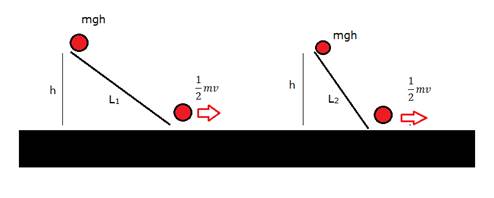
Solution 5a
Given that,
Power, P = 2 kW =2000 W
Height, h = 10 m
Now,
Work = Power × time = 2000× 60
∴ W =12,0000 J
Now, the amount of work done to pint water upto height 10 m.
P.E = mgh = 12,0000 J
∴ Section name
Solution 5b
Given that,
Power, P =1200 W
Time, t = 30 min = 30× 60
Total days in April, d = 30 days
Now,
Energy per month = Power × time × number of days
∴ E=1200 × 30× 60× 30
E= 64.8 × 106 J
i.e.,
![]()
Solution 5c
Given that,
Height, h = 10 m
Now,
Energy of ball at 10 m height, Eh = mgh =10mg
If height reduced by 40 % then the energy will be
E' =60 % of Eh =
Solution 5d
Given that,
Final velocity of car, v = 72 km/hr =20 m/s
Initial velocity of car, u = 54 km/hr = 15 m/s
Mass, m= 1500 kg
Now, according to work energy theorem
Work done, W = ΔK.E
Solution 5e
Given that,
Force, F = 10 N
Displacement, s = 30 cm = 0.3 m
Now,
Work = Force× displacement
i.e., W= 10× 0.3 × cos 0° =3 J

